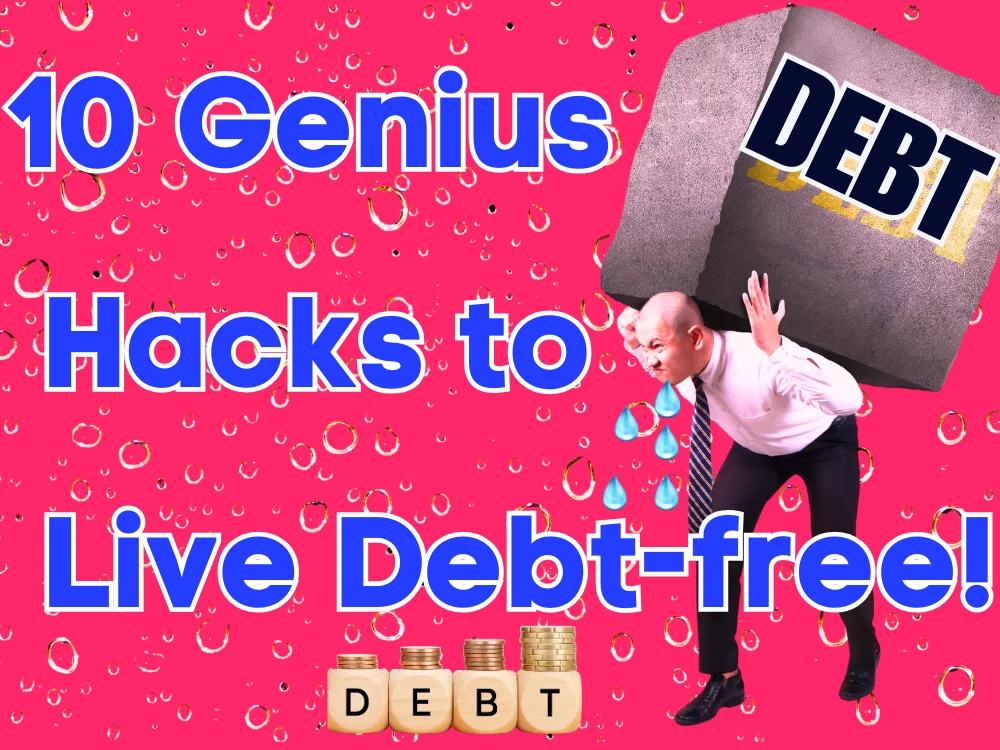The burden of debt can weigh heavily on individuals, it’s a heavy load to carry, causing stress and limiting opportunities. We’re going to explore 10 genius hacks to live debt-free. If you’ve been drowning in debt and looking for ways to break free from the financial shackles, this article is going to empower you with the tips needed to say goodbye to debt and take control of your financial future.
Table of Contents
What Is Debt?
Debt is a financial obligation arising from the borrowing of funds with an agreement to repay the lender, typically with interest, over a specified period. It represents the amount owed by the debtor to the creditor. For example, when you obtain a $100 loan from a financial institution and commit to returning the principal amount along with interest within a predetermined timeframe, you incur a debt of $100 to the lending institution. Effective debt management is important, as failure to meet repayment obligations can result in additional interest charges and adverse financial consequences.
Types Of Debts
There are various types of debts, each with its unique characteristics, as we are going to learn shortly:
- Consumer Debt: This type of debt is incurred by people for personal consumption, such as credit card debt, personal loans, or payday loans. Consumer debts often carry higher interest rates compared to other types of debt due to their unsecured nature.
- Mortgage Debt: Mortgage debt is associated with financing the purchase of a home or real estate. It involves a long-term loan secured by the property itself. The borrower pays back the loan over many years, typically 15 to 30 years. To assist you in controlling and keeping track of your mortgage debt, consider using this tracker. Mortgage Tracker
- Student Loan Debt: Student loan debt arises from borrowing money to finance higher education. These loans may have lower interest rates and flexible repayment options for students, but they can still accumulate significantly over time.
- Auto Loan Debt: When you borrow money to purchase a vehicle, it’s known as auto loan debt. The vehicle serves as collateral, and the loan is repaid in instalments over a set period.
- Business Debt: Business debt is incurred by companies to finance operations, expansion, or capital investments. It can include loans, lines of credit, or bonds. Business debt can be secured (backed by collateral) or unsecured (based on the company’s creditworthiness).
- Secured Debt: Secured debt is tied to an asset or collateral, which the lender can claim if the borrower fails to repay the loan. Examples include mortgage loans and auto loans. The presence of collateral often results in lower interest rates.
- Unsecured Debt: Unsecured debt doesn’t require collateral and relies solely on the borrower’s creditworthiness. Credit card debt and personal loans are common examples. Due to the higher risk for lenders, unsecured debts usually have higher interest rates.
- Government Debt: Governments may borrow money by issuing bonds or Treasury bills to fund various projects, services, or budget deficits. Investors purchase these bonds, and the government pays them back with interest over time.
- Medical Debt: Medical debt accrues when individuals can’t afford to pay their medical bills or medical expenses not covered by insurance. It can result from hospital stays, surgeries, or other healthcare services.
- Payday Loans: Payday loans are short-term, high-interest loans often used by individuals facing immediate financial needs. They typically require repayment on the borrower’s next payday, but they can carry substantial fees and interest charges.
Understand Debt Repayment
Debt repayment involves the process of paying off borrowed money. It plays a vital role in achieving long-term financial stability. It is essential to differentiate between good debts, which are investments that generate income or appreciate in value, and bad debts, which are liabilities that do not provide a return. Debt repayment also has psychological aspects, including the emotional impact of being in debt and the sense of accomplishment when overcoming it.
Create a Debt Repayment Plan
Developing a well-structured debt repayment plan is crucial to effectively manage your obligations. Start by assessing your current financial situation, including your income, expenses, and the total amount of debt you owe. Then, consider different debt repayment strategies, such as the snowball method (paying off debts from smallest to largest) or the avalanche method (tackling debts with the highest interest rates first).
Reframe Your Financial Mindset
Mastering the art of debt repayment requires a shift in mindset. It’s important to prioritize debt repayment over discretionary spending, and to identify and overcome any financial habits that hinder progress. Implementing effective budgeting techniques, such as the 50/30/20 rule (50% of income for necessities, 30% for wants, and 20% for debt repayment and savings), can also significantly contribute to your debt-free journey.
Cut Back Expenses for Faster Debt Repayment
Reducing expenses is a key strategy for accelerating debt repayment. Start by identifying discretionary expenses and making conscious choices to reduce them. Try other alternative cost-saving strategies, such as meal prepping to avoid eating out or DIY projects to save on labor costs. Additionally, regularly track your expenses and adjust your spending habits accordingly. Don’t forget to always use a tracker to monitor your income and expenses.
Boost Your Income to Accelerate Debt Repayment
Consider increasing your income to provide an additional boost to your debt repayment efforts. Explore opportunities for side hustles or part-time jobs that are capable of generating extra cash flow. Maximize your existing income by negotiating for better pay or seeking career advancements. Finally, consider utilizing windfalls or unexpected income to make larger debt payments and expedite your journey towards a debt-free life.
Negotiate with Your Creditors and Lenders
One effective approach to debt repayment is open communication with creditors and lenders. You can do this by engaging in discussions, you may negotiate better terms, interest rates, or even settlements. Additionally, researching options for refinancing loans or consolidating debts can lead to better loan structures. It’s also important to know when to seek professional assistance if the burden of debt becomes overwhelming.
Harness the Power of Debt Repayment Apps and Tools
In today’s digital age, there are various debt management apps and tools available that can simplify and streamline your debt repayment journey. These tools often offer features such as automated payments and progress tracking. Consider leveraging technology to stay organized and motivated as you work towards becoming debt-free.
Overcoming Debt Traps and Temptations
You’ll agree with me that identifying common debt traps will definitely prevent you from falling into them. Be cautious of high-interest credit cards, predatory lending practices, and impulsive spending. It’s also important to resist temptations to take on additional debt while repaying your existing obligations, this is where wisdom comes into play. You need to constantly remind yourself to stay motivated, remember your long-term financial goals and the benefits of being debt-free.
Celebrating Milestones and Progress
Don’t be too hard on yourself, remember a journey of a thousand miles starts with a step! To maintain motivation throughout your debt repayment journey, it’s important to celebrate milestones and acknowledge your progress. Find ways to reward yourself without compromising your financial goals. For example, treat yourself to a small indulgence or plan a budget-friendly outing. Maintaining a positive mindset and recognizing your achievements will reinforce your commitment to living a debt-free life.
I am convinced that these 10 Genius Hacks to Live Debt-free have equipped you with the much-needed tips you need to turn your financial story around. Remember that mastering the art of debt repayment requires a comprehensive approach that encompasses understanding debt, creating a repayment plan, reframing your financial mindset, cutting back expenses, boosting income, negotiating with creditors, utilizing debt repayment apps and tools, overcoming debt traps, celebrating milestones, and staying motivated. Go ahead and implement these 10 genius hacks to live debt-free if you’re determined to overcome debt burden, reclaim your financial freedom and achieve a debt-free life.
Let’s quickly address some of the questions that may be flowing around in your mind!
FAQs (Frequently Asked Questions)
- How long does it typically take to become debt-free?
- The timeline for becoming debt-free varies depending on factors such as the amount of debt, the repayment strategy, and your financial situation. It is important to create a realistic plan and stick to it consistently.
- Are there any risks associated with debt consolidation?
- Debt consolidation can be a useful strategy to simplify payments and potentially lower interest rates. However, it’s essential to carefully consider the terms and fees associated with consolidation, as well as the potential impact on your credit score.
- Should I focus on repaying my debts or saving for emergencies?
- While it’s important to have an emergency fund for unexpected expenses, it is generally advisable to prioritize debt repayment. High-interest debts can quickly accumulate and impede your financial progress. Finding a balance between debt repayment and saving is ideal.
- What if I have multiple debts with varying interest rates?
- In such cases, consider using a debt repayment strategy like the avalanche method, which prioritizes paying off debts with the highest interest rates first. This approach helps save money on interest payments in the long run.
- Can I still enjoy life while repaying my debts?
- Absolutely! Living a debt-free life doesn’t mean sacrificing everything. It requires making conscious choices, cutting back on unnecessary expenses, and finding affordable alternatives. By adopting a balanced approach, you can still enjoy fulfilling experiences while working towards your debt-free goals.
Feel Free To Check out some Useful Tools and Resources Below :


